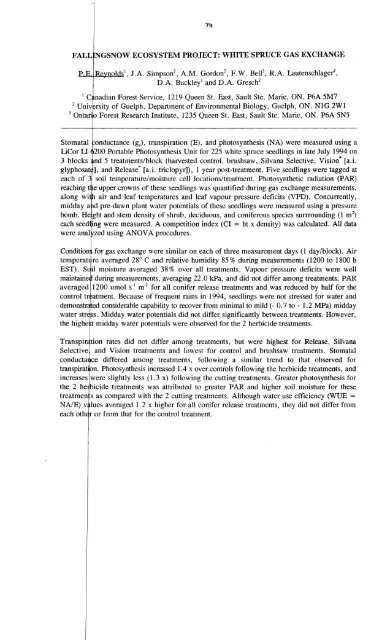Vol. 51â1997 - NorthEastern Weed Science Society
Vol. 51â1997 - NorthEastern Weed Science Society
Vol. 51â1997 - NorthEastern Weed Science Society
You also want an ePaper? Increase the reach of your titles
YUMPU automatically turns print PDFs into web optimized ePapers that Google loves.
74<br />
GSNOW ECOSYSTEM PROJECT:<br />
WHITE SPRUCE GAS EXCHANGE<br />
R n I I, J.A. Simpson", A.M. Gordon", F.W. Bell3, R.A. Lautenschlager',<br />
D.A. Buckley! and D.A. Gresch'<br />
1 C nadian Forest Service, 1219 Queen St. East, Sault Ste. Marie, ON. P6A 5M7<br />
2 Univ rsity of Guelph, Department of Environmental Biology, Guelph, ON. NIG 2Wl<br />
3 Ontari Forest Research Institute, 1235 Queen St. East, Sault Ste. Marie, ON. P6A 5N5<br />
Stomatal onductance (gs), transpiration (E), and photosynthesis (NA) were measured using a<br />
LiCor U- 200 Portable Photosynthesis Unit for 225 white spruce seedlings in late July 1994 on<br />
3 blocks nd 5 treatments/block (harvested control, brushsaw, Silvana Selective, Vision" raj.<br />
glyphosat ], and Release" raj. triclopyrl), 1 year post-treatment. Five seedlings were tagged at<br />
each of 3 soil temperature/moisture cell locations/treatment. Photosynthetic radiation (PAR)<br />
reaching e upper crowns of these seedlings was quantified during gas exchange measurements,<br />
along wi air and leaf temperatures and leaf vapour pressure deficits (VPD). Concurrently,<br />
midday a d pre-dawn plant water potentials of these seedlings were measured using a pressure<br />
bomb. He ght and stem density of shrub, deciduous, and coniferous species surrrounding (1 m 2 )<br />
each seed ing were measured. A competition index (CI = ht x density) was calculated. All data<br />
were anal zed using ANOVA procedures.<br />
Condition for gas exchange were similar on each of three measurement days (1 day/block). Air<br />
temperat re averaged 28 0 C and relative humidity 85% during measurements (1200 to 1800 h<br />
EST). S il moisture averaged 38% over all treatments. Vapour pressure deficits were well<br />
maintain during measurements, averaging 22.0 kPa, and did not differ among treatments. PAR<br />
averaged 1200 umol S-I m- 2 for all conifer release treatments and was reduced by half for the<br />
control tr atment. Because of frequent rains in 1994, seedlings were not stressed for water and<br />
demons ed considerable capability to recover from minimal to mild (- 0.7 to 1.2 MPa) midday<br />
water str ss. Midday water potentials did not differ significantly between treatments. However,<br />
the highe t midday water potentials were observed for the 2 herbicide treatments.<br />
Transpir tion rates did not differ among treatments, but were highest for Release, Silvana<br />
Selective and Vision treatments and lowest for control and brushsaw treatments. Stomatal<br />
conducta ce differed among treatments, following a similar trend to that observed for<br />
transpirat n. Photosynthesis increased 1.4 x over controls following the herbicide treatments, and<br />
increases were slightly less (1.3 x) following the cutting treatments. Greater photosynthesis for<br />
the 2 he bicide treatments was attributed to greater PAR and higher soil moisture for these<br />
treatmen s as compared with the 2 cutting treatments. Although water use efficiency (WUE =<br />
NA/E) v lues averaged 1.2 x higher for all conifer release treatments, they did not differ from<br />
each oth r or from that for the control treatment.
















